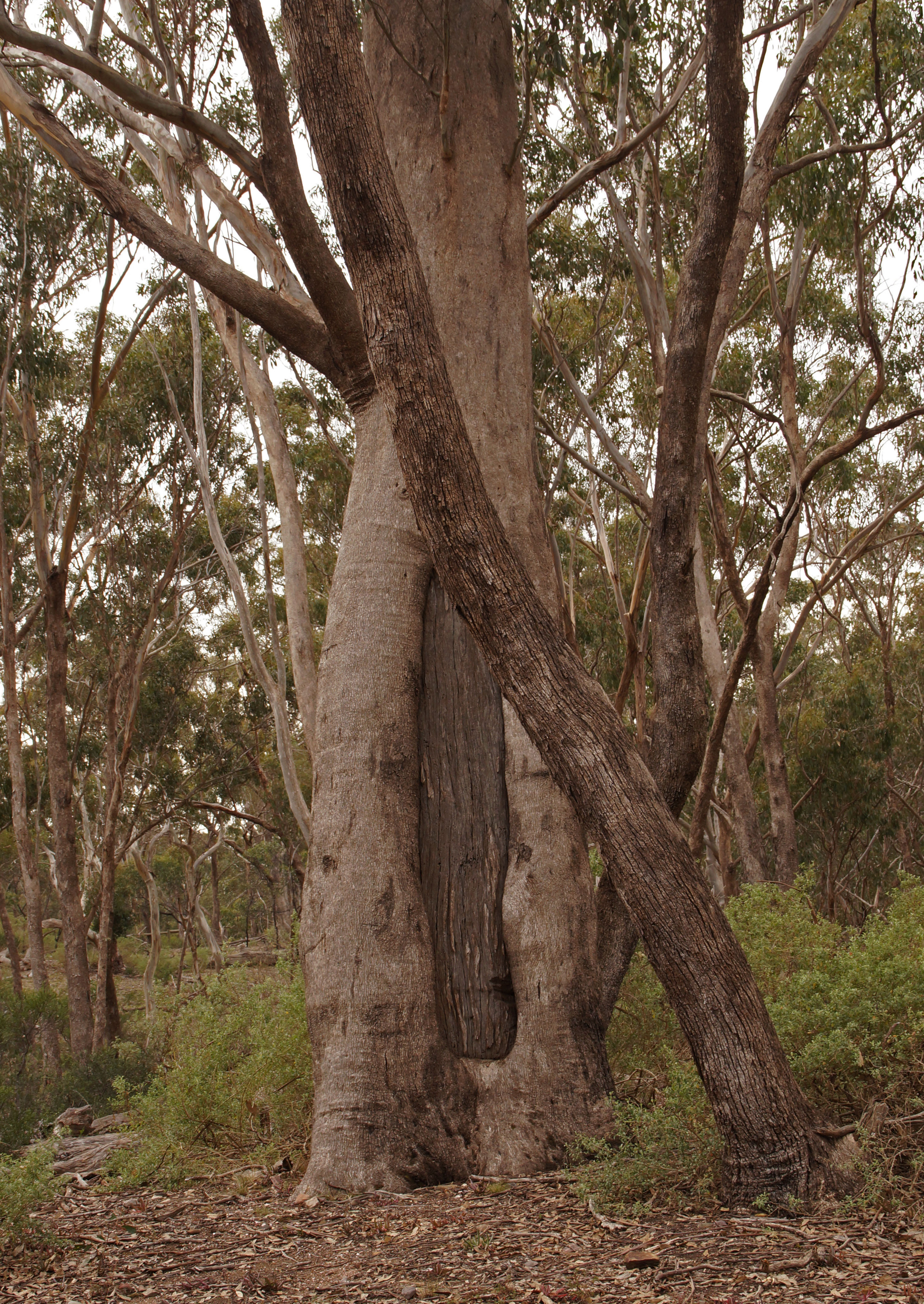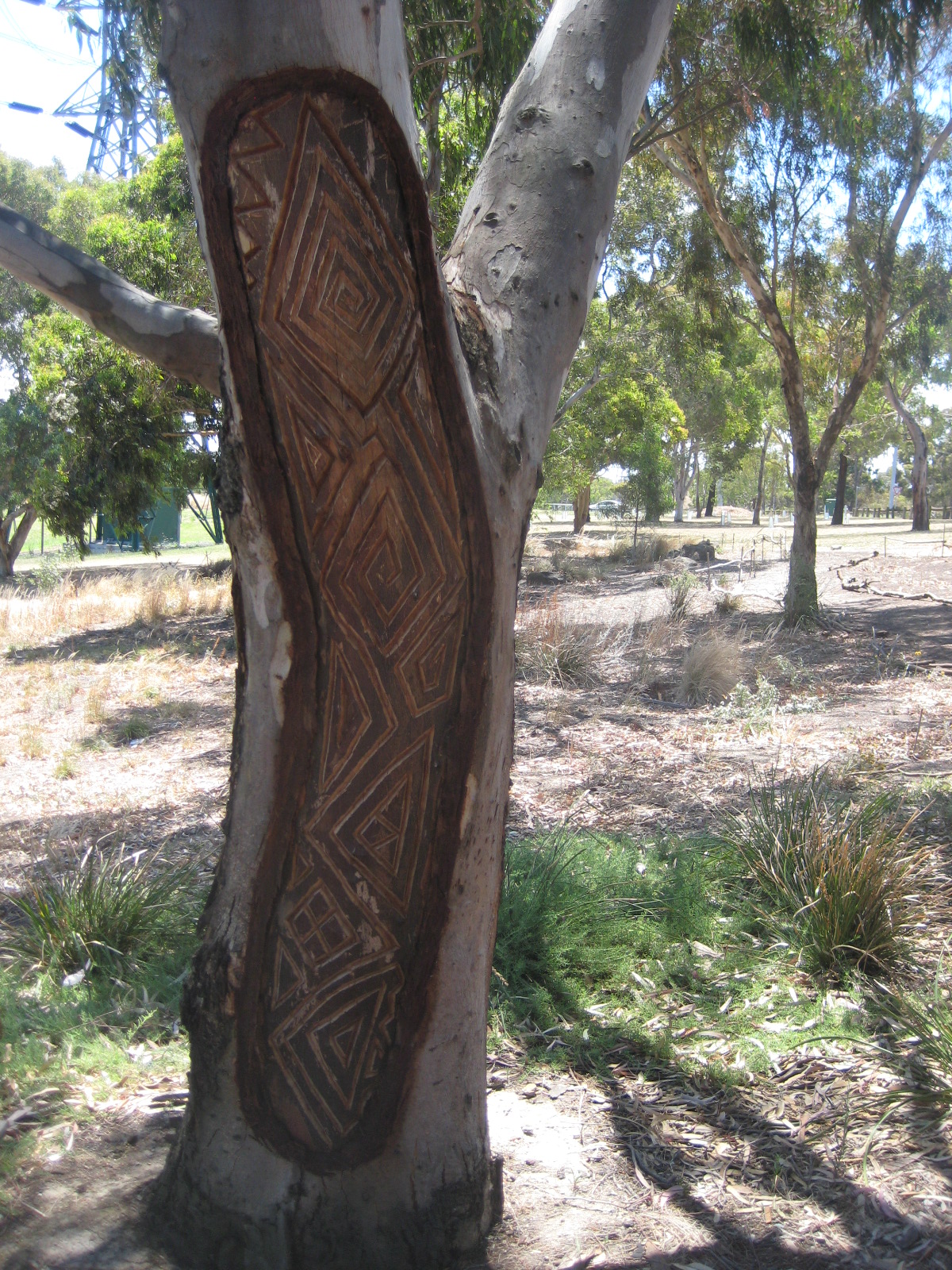Scarred Trees on:
[Wikipedia]
[Google]
[Amazon]
A scarred tree or scar tree, also known as a canoe tree and shield tree, is a tree which has had
 Bark was removed by making deep cuts in a tree with a stone pickaxe or other similar tool. The area of bark removed is typically regular in shape, often with parallel sides and slightly pointed or rounded ends, and the scar usually stops above ground level. Australian native
Bark was removed by making deep cuts in a tree with a stone pickaxe or other similar tool. The area of bark removed is typically regular in shape, often with parallel sides and slightly pointed or rounded ends, and the scar usually stops above ground level. Australian native


 Carved trees are mainly found in
Carved trees are mainly found in
Scarred Trees: An Identification and recording manual
{{Indigenous Australians Australian Aboriginal bushcraft History of Indigenous Australians
bark
Bark may refer to:
* Bark (botany), an outer layer of a woody plant such as a tree or stick
* Bark (sound), a vocalization of some animals (which is commonly the dog)
Places
* Bark, Germany
* Bark, Warmian-Masurian Voivodeship, Poland
Arts, ...
removed by Aboriginal Australians
Aboriginal Australians are the various Indigenous peoples of the Mainland Australia, Australian mainland and many of its islands, such as Tasmania, Fraser Island, Hinchinbrook Island, the Tiwi Islands, and Groote Eylandt, but excluding the T ...
for the creation of bark canoes, shelters, weapons such as shield
A shield is a piece of personal armour held in the hand, which may or may not be strapped to the wrist or forearm. Shields are used to intercept specific attacks, whether from close-ranged weaponry or projectiles such as arrows, by means of ...
s, tools, traps, containers (such as coolamons) or other artefacts. Carved trees are created as a form of artistic and spiritual expression by some Aboriginal peoples, to mark sites of significance such as burial sites.
Description
 Bark was removed by making deep cuts in a tree with a stone pickaxe or other similar tool. The area of bark removed is typically regular in shape, often with parallel sides and slightly pointed or rounded ends, and the scar usually stops above ground level. Australian native
Bark was removed by making deep cuts in a tree with a stone pickaxe or other similar tool. The area of bark removed is typically regular in shape, often with parallel sides and slightly pointed or rounded ends, and the scar usually stops above ground level. Australian native Eucalypt
Eucalypt is a descriptive name for woody plants with capsule fruiting bodies belonging to seven closely related genera (of the tribe Eucalypteae) found across Australasia:
''Eucalyptus'', '' Corymbia'', '' Angophora'', '' Stockwellia'', '' Allo ...
species such as box and red gum (especially in Victoria), or whichever species are native in the area. Scars remain in trees that are often over 200 years old. Sometimes there is exposed sapwood
Wood is a porous and fibrous structural tissue found in the stems and roots of trees and other woody plants. It is an organic materiala natural composite of cellulose fibers that are strong in tension and embedded in a matrix of lignin t ...
at the base or at the top of the scar, showing axe cuts.
Aboriginal people removed bark from trees to make things like canoes, containers and shields, as well as to build temporary shelters. Sometimes they cut toe holds for ease of climbing, with the trees used as lookout
A lookout or look-out is a person in charge of the observation of hazards. The term originally comes from a naval background, where lookouts would watch for other ships, land, and various dangers. The term has now passed into wider parlance.
...
s or to hunt for bush foods.
To remove bark, the Aboriginal people cut an outline of the shape they wanted using stone axes or, once Europeans had arrived, steel axes. The bark was then levered off. Sometimes the axe marks made by Aboriginal people are still visible on the sapwood of the tree, but usually the marks will be hidden because the bark has grown back. The amount of bark regrowth may help you tell the age of the scar. Sometimes, if the scar is very old, it will be completely covered by regrowth
Non-Indigenous Australians
Indigenous Australians or Australian First Nations are people with familial heritage from, and membership in, the ethnic groups that lived in Australia before British colonisation. They consist of two distinct groups: the Aboriginal peoples o ...
called the trees thus marked as scarred trees, scar trees, canoe trees or shield trees.
In the 17th century, dugout canoe
A dugout canoe or simply dugout is a boat made from a hollowed tree. Other names for this type of boat are logboat and monoxylon. ''Monoxylon'' (''μονόξυλον'') (pl: ''monoxyla'') is Greek – ''mono-'' (single) + '' ξύλον xylon'' ( ...
technology appeared in Australia, to supplement the bark canoe, causing many changes to both the hunting practices and the society of the Aboriginal peoples.
Carved trees


New South Wales
)
, nickname =
, image_map = New South Wales in Australia.svg
, map_caption = Location of New South Wales in AustraliaCoordinates:
, subdivision_type = Country
, subdivision_name = Australia
, established_title = Before federation
, es ...
, and are the work specifically of Gamilaroi and Wiradjuri
The Wiradjuri people (; ) are a group of Aboriginal Australian people from central New South Wales, united by common descent through kinship and shared traditions. They survived as skilled hunter-fisher-gatherers, in family groups or clans, a ...
artists. They were created to mark sites of particular ceremonial significance, such as initiation or burial sites. They are also known as arborglyphs, dendroglyphs and teleteglyphs.
During the 19th century, sections of these carved trees were removed and placed in museums, but there is now a move not only to return these trees to the land of origin, but also to revive the practice of carved trees.Locations
Scarred trees are found among mature native trees, especially box gum and red gum trees, along rivers and lakes and at sacred sites. They are protected by legislation. Canoe trees have been photographed along theMurray River
The Murray River (in South Australia: River Murray) ( Ngarrindjeri: ''Millewa'', Yorta Yorta: ''Tongala'') is a river in Southeastern Australia. It is Australia's longest river at extent. Its tributaries include five of the next six longe ...
at Waikerie and Kroehns Landing at Nildottie in South Australia, and on the Murrumbidgee River
The Murrumbidgee River () is a major tributary of the Murray River within the Murray–Darling basin and the second longest river in Australia. It flows through the Australian state of New South Wales and the Australian Capital Territory, des ...
near Hay, New South Wales
Hay is a town in the western Riverina region of south western New South Wales, Australia. It is the administrative centre of Hay Shire local government area and the centre of a prosperous and productive agricultural district on the wide Hay Pla ...
.
RMIT Bundoora, Victoria has six scarred trees on their campus. They have developed a self-guided tour
A self-guided tour is a self-governing tour where one navigates a route oneself as opposed to an escorted tour where a tour guide directs the route, times, information, and places toured."self-guided adj." The New Oxford American Dictionary, sec ...
trail or information can be found on their website.
See also
*Australian Aboriginal artefacts
Australian Aboriginal artefacts include a variety of cultural artefacts used by Aboriginal Australians. Most Aboriginal artefacts were multi-purpose and could be used for a variety of different occupations. Spears, clubs, boomerangs and shi ...
References
Further reading
* * – Canoe tree at Currency Creek, South Australia * * – Gallery of photos of scar trees inNew South Wales
)
, nickname =
, image_map = New South Wales in Australia.svg
, map_caption = Location of New South Wales in AustraliaCoordinates:
, subdivision_type = Country
, subdivision_name = Australia
, established_title = Before federation
, es ...
Scarred Trees: An Identification and recording manual
{{Indigenous Australians Australian Aboriginal bushcraft History of Indigenous Australians